Related Research Articles
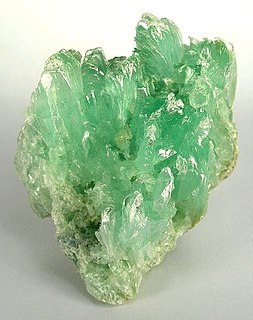
Talc, or talcum, is a clay mineral, composed of hydrated magnesium silicate with the chemical formula Mg3Si4O10(OH)2. Talc in powdered form, often combined with corn starch, is used as baby powder. This mineral is used as a thickening agent and lubricant. It is an ingredient in ceramics, paints, and roofing material. It is a main ingredient in many cosmetics. It occurs as foliated to fibrous masses, and in an exceptionally rare crystal form. It has a perfect basal cleavage and an uneven flat fracture, and it is foliated with a two-dimensional platy form.
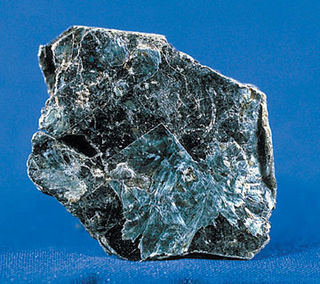
Vermiculite is a hydrous phyllosilicate mineral which undergoes significant expansion when heated. Exfoliation occurs when the mineral is heated sufficiently, and commercial furnaces can routinely produce this effect. Vermiculite forms by the weathering or hydrothermal alteration of biotite or phlogopite. Large commercial vermiculite mines currently exist in the United States, Russia, South Africa, China, and Brazil.

A scalpel, lancet, or bistoury is a small and extremely sharp bladed instrument used for surgery, anatomical dissection, podiatry and various arts and crafts. Scalpels may be single-use disposable or re-usable. Re-usable scalpels can have permanently attached blades that can be sharpened or, more commonly, removable single-use blades. Disposable scalpels usually have a plastic handle with an extensible blade and are used once, then the entire instrument is discarded. Scalpel blades are usually individually packed in sterile pouches but are also offered non-sterile. Double-edged scalpels are referred to as "lancets".

Brucite is the mineral form of magnesium hydroxide, with the chemical formula Mg(OH)2. It is a common alteration product of periclase in marble; a low-temperature hydrothermal vein mineral in metamorphosed limestones and chlorite schists; and formed during serpentinization of dunites. Brucite is often found in association with serpentine, calcite, aragonite, dolomite, magnesite, hydromagnesite, artinite, talc and chrysotile.

Mesothelioma is a type of cancer that develops from the thin layer of tissue that covers many of the internal organs. The most common area affected is the lining of the lungs and chest wall. Less commonly the lining of the abdomen and rarely the sac surrounding the heart, or the sac surrounding the testis may be affected. Signs and symptoms of mesothelioma may include shortness of breath due to fluid around the lung, a swollen abdomen, chest wall pain, cough, feeling tired, and weight loss. These symptoms typically come on slowly.
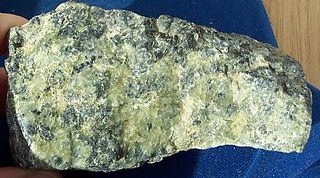
The serpentine subgroup are greenish, brownish, or spotted minerals commonly found in serpentinite rocks. They are used as a source of magnesium and asbestos, and as a decorative stone. The name is thought to come from the greenish color being that of a serpent.

Pneumoconiosis is the general term for a class of interstitial lung disease where inhalation of dust has caused interstitial fibrosis. The three most common types are asbestosis, silicosis, and coal miner's lung. Pneumoconiosis often causes restrictive impairment, although diagnosable pneumoconiosis can occur without measurable impairment of lung function. Depending on extent and severity, it may cause death within months or years, or it may never produce symptoms. It is usually an occupational lung disease, typically from years of dust exposure during work in mining; textile milling; shipbuilding, ship repairing, and/or shipbreaking; sandblasting; industrial tasks; rock drilling ; or agriculture. It is one of the most common occupational diseases in the world.

Asbestosis is long-term inflammation and scarring of the lungs due to asbestos fibers. Symptoms may include shortness of breath, cough, wheezing, and chest tightness. Complications may include lung cancer, mesothelioma, and pulmonary heart disease.

Chrysotile or white asbestos is the most commonly encountered form of asbestos, accounting for approximately 95% of the asbestos in the United States and a similar proportion in other countries. It is a soft, fibrous silicate mineral in the serpentine subgroup of phyllosilicates; as such, it is distinct from other asbestiform minerals in the amphibole group. Its idealized chemical formula is Mg3(Si2O5)(OH)4. The material has physical properties which make it desirable for inclusion in building materials, but poses serious health risks when dispersed into air and inhaled.
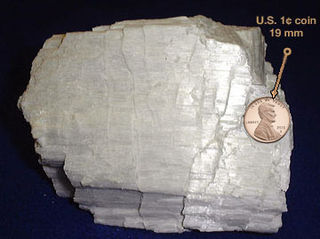
Wollastonite is a calcium inosilicate mineral (CaSiO3) that may contain small amounts of iron, magnesium, and manganese substituting for calcium. It is usually white. It forms when impure limestone or dolomite is subjected to high temperature and pressure, which sometimes occurs in the presence of silica-bearing fluids as in skarns or in contact with metamorphic rocks. Associated minerals include garnets, vesuvianite, diopside, tremolite, epidote, plagioclase feldspar, pyroxene and calcite. It is named after the English chemist and mineralogist William Hyde Wollaston (1766–1828).

Tremolite is a member of the amphibole group of silicate minerals with composition: Ca2(Mg5.0-4.5Fe2+0.0-0.5)Si8O22(OH)2. Tremolite forms by metamorphism of sediments rich in dolomite and quartz. Tremolite forms a series with actinolite and ferro-actinolite. Pure magnesium tremolite is creamy white, but the color grades to dark green with increasing iron content. It has a hardness on Mohs scale of 5 to 6. Nephrite, one of the two minerals of the gemstone jade, is a green variety of tremolite.
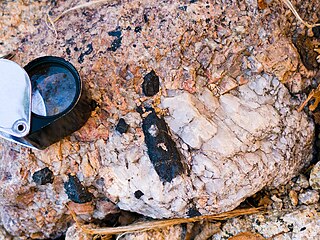
Riebeckite is a sodium-rich member of the amphibole group of silicate minerals, chemical formula Na2(Fe2+3Fe3+2)Si8O22(OH)2. It forms a solid solution series with magnesioriebeckite. It crystallizes in the monoclinic system, usually as long prismatic crystals showing a diamond-shaped cross section, but also in fibrous, bladed, acicular, columnar, and radiating forms. Its Mohs hardness is 5.0–6.0, and its specific gravity is 3.0–3.4. Cleavage is perfect, two directions in the shape of a diamond; fracture is uneven, splintery. It is often translucent to nearly opaque.
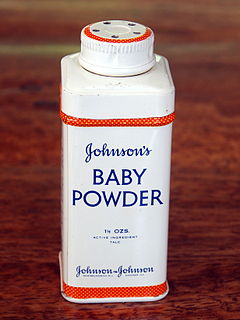
Baby powder is an astringent powder used for preventing diaper rash and for cosmetic uses. It may be composed of talc or corn starch. It may also contain additional ingredients like fragrances. Baby powder can also be used as a dry shampoo, cleaning agent, and freshener.
Occupational lung diseases are work-related, lung conditions that have been caused or made worse by the materials a person is exposed to within the workplace. It includes a broad group of diseases, including occupational asthma, industrial bronchitis, chronic obstructive pulmonary disease (COPD), bronchiolitis obliterans, inhalation injury, interstitial lung diseases, infections, lung cancer and mesothelioma. These diseases can be caused directly or due to immunological response to an exposure to a variety of dusts, chemicals, proteins or organisms.
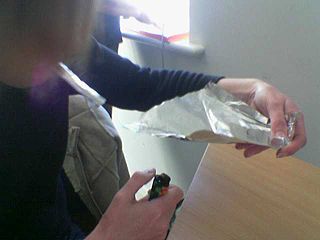
"Chasing the dragon" (CTD), or "foily" in Australian English, refers to inhaling the vapor from a heated solution of a powdered psychoactive drug on a sheet of aluminum foil. The moving vapor is chased after with a tube through which the user inhales. The "chasing" occurs as the user gingerly keeps the liquid moving in order to keep it from overheating and burning up too quickly, on a heat conducting material such as aluminium foil.

Environmental epidemiology is a branch of epidemiology concerned with determining how environmental exposures impact human health. This field seeks to understand how various external risk factors may predispose to or protect against disease, illness, injury, developmental abnormalities, or death. These factors may be naturally occurring or may be introduced into environments where people live, work, and play.

Asbestos is a naturally occurring fibrous silicate mineral. There are six types, all of which are composed of long and thin fibrous crystals, each fibre being composed of many microscopic "fibrils" that can be released into the atmosphere by abrasion and other processes. Inhalation of asbestos fibres can lead to various dangerous lung conditions, including mesothelioma, asbestosis, and lung cancer, so it is now notorious as a serious health and safety hazard.

Peritoneal mesothelioma is the name given to the cancer that attacks the lining of the abdomen. This type of cancer affects the lining that protects the contents of the abdomen and which also provides a lubricating fluid to enable the organs to move and work properly.

Balangeroite is found in one of the most important chrysotile mines in Europe, the Balangero Serpentinite. Hence, it is usually mistaken as an asbestiform in an assemblage of other mineral phases like chrysotile, magnetite and Fe-Ni alloys. However, Balangeroite does not lead to serious health problems caused by asbestos fibers.
Mineral dust airway disease is a general term used to describe complications due to inhaled mineral dust causing fibrosis and narrowing of primarily the respiratory bronchioles. It is a part of a group of disorders known as pneumoconioses which is characterized by inhaled mineral dust and the effects on the lungs.
References
- ↑ Roberts, Matt T. & Don Etherington. "Asbestine". Bookbinding and the Conservation of Books: A Dictionary of Descriptive Terminology. Archived from the original on 2007-02-23. Retrieved 2009-01-29.
- ↑ Chambers, Ephraim. "asbestine". Cyclopaedia. Archived from the original on 9 March 2009. Retrieved 2009-01-29.
- ↑ Hitchcock, H.R. (1960). "review: A Century of Minnesota Architecture by Donald R. Torbert". Journal of the Society of Architectural Historians. 19 (1): 39–40. doi:10.2307/987968. ISSN 0037-9808. JSTOR 987968.
- ↑ Office of the Attorney General; Government of Ireland. "S.I. No. 287/1949 — Standard Specification (Extenders For Paints) Order, 1949". Irish Statute Book.
- ↑ Rohl, Arthur N.; Langer, Arthur M.; National Institute of Environmental Health Sciences (NIEHS) (1974). "Identification and quantitation of asbestos in talc". Environmental Health Perspectives. 9: 95–109. doi:10.1289/ehp.74995. ISSN 0091-6765. JSTOR 3428261. PMC 1475418 . PMID 4470959.
- ↑ Schepers, G.W.H (1964). "Pneumoconiosis". The American Journal of Nursing. 64 (2): 109–114. doi:10.1097/00000446-196402000-00033. ISSN 0002-936X. JSTOR 3452977. PMID 14123383.
![]() This article incorporates text from a publication now in the public domain : Chambers, Ephraim, ed. (1728). "Asbestine". Cyclopædia, or an Universal Dictionary of Arts and Sciences (1st ed.). James and John Knapton, et al.
This article incorporates text from a publication now in the public domain : Chambers, Ephraim, ed. (1728). "Asbestine". Cyclopædia, or an Universal Dictionary of Arts and Sciences (1st ed.). James and John Knapton, et al.